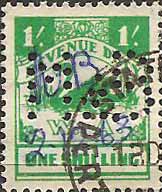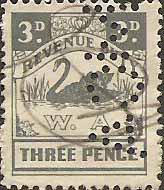|
Private Revenue Perfins of Western Australia An Elsmore Coath production The authors would welcome your comments additions or input into this work B C D F G H I K L M N O P R V W Other M -------------------------------------------------------- M&B.a
User: A D Meares and Bishop Stockbrokers Address: 33 Bligh St, Sydney, NSW. Revenue Use: 1951-63 issue 3d, 1/-. Rarity Scale: 1951-63 issue 3d R3, 1/- R2. Background: Alfred
Meares was born in Sydney in November 1904 and in
1926 he became a clerk at the Sydney Stock
Exchange. In 1932 he took a seat at the Sydney
Exchange and worked for a small group of private
clients.
After an absence for
military service in World War 2 he returned to his
seat and in 1949 he went into partnership with
Jesse Bishop as A D Meares and Bishop.
Jesse Bishop had been
born in Sydney in 1907 and was educated at Sydney
University but completed his studies at Cambridge
in England. Graduating in 1934 he worked for the
Imperial Smelting Corporation for a short period
before gaining a position with the stockbroking
firm W Thompson and Son. and later Dormer Rumball
and Co. in which he secured a partnership and a
seat on the London Stock Exchange in 1940.
As with his future
partner his career was punctuated by the war.
After the war he worked in the legal department at
Shell before returning to Australia for family
reasons in 1948.
In 1949 he joined the
Sydney Stock Exchange as a sole trader but soon
joined fellow sole trader Meares. The partnership soon
moved from its small client base to become
involved in some major share floats including
Yates Seeds, Ampol Exploration, Canberra
Television, J B Young and Thomas Nationwide
Transport (TNT).
Bishop remained with
the firm until 1965 and Meares retired from his
role in the firm in 1970.
Device: The M&B
pattern is found on the revenue stamps of
Queensland, New South Wales, Victoria, Tasmania as
well as Western Australia. All of the strikes are
identical and Meares and Bishop are not known to
have had offices or seats on Stock Exchanges other
than in Sydney. Given this it is reasonable to
assume that the device was located in Sydney and
applied to revenue stamps of various States as
required to process transactions within the
jurisdiction of a given State revenue office. This
is supported by company stamps applied to
documents that all show the Bligh Street, Sydney
address.
Multiples of this
pattern show an inconsistent relationship to each
other so the device is most likely a single head
one. This is supported by the fact that the
strikes are identical which is less likely on a
multiple die device, which often show variation
between dies.
The M&B device is
only found on revenue stamps and the use on
documents shows that the stamps are punctured
prior to being affixed, indicating use as a
security device rather than a cancelling device.
The use as a security device to prevent theft is
further supported by the fact that once affixed
the stamps are then cancelled either by pen,
company cachet or circular punch. The device was used
between 1962 and 1967.
Related Patterns:
Refer to other usage of this A D Meares and Bishop
device in:
NSW:
M&B.a
QLD:
M&B.a
TAS:
M&B.a
VIC:
M&B.a -------------------------------------------------------- MOA.a User: Mobil Oil Australia Oil Manufacturers and Suppliers Address: Revenue Use: 1951-63 issue 3d, 10/-. Rarity Scale: 1951-63 issue 3d R3, 10/- R4. Background: Mobil Oil Australia was
formed in 1963 having previously been known in
Australia as the Vacuum Oil Company. Vacuum Oil started operating in the
United States in the 1860 and in 1895 became the
first oil company to be established in Australia. Up
until that time foreign oil products were marketed
in Australia via agents. Vacuum Oil first opened offices in
Melbourne and they were incorporated in 1904. In
1908 they merged with the Colonial Oil Company and
they progressively expanded throughout Australia
with offices, processing and distribution facilities
in Sydney, Townsville, Perth, Fremantle, Port
Adelaide, Newcastle, Hobart and other locations. In
1924 they opened a bulk terminal at Pulpit Point in
Sydney. They opened processing facilities in Altona
(Melbourne) in 1940 and at Port Stanvac (South of
Adelaide) in 1963. In 1930 the US parent company
merged with Standard Oil to become Socony Vacuum and
later Socony Mobil but the Australian operation
remained Vacuum Oil until it changed its name to
Mobil Oil Australia in 1963. Device: This MOA device located in
Perth is the only perfin device to be used by the
renamed company. There were about 7 VOCO
devices still in use in the 1950’s but only the
devices in Perth, Melbourne and Newcastle were still
in use in the early 1960’s, when the name change
occured. This MOA device is also found used
on postage stamps but this usage is short lived and
is limited to 1962-63. The MOA device was most likely a
single head device as it is found to produce central
strikes in a range of stamp sizes from the small WA
revenues to larger format postage stamps. For more information about Vacuum
Oil devices see the “Study of Vacuum Oil Patterns
used in Australia” under the Perfins Research tab at
www.perfins.com.au
Related patterns: Refer to other
Vacuum Oil/Mobil Oil Company patterns in: NSW: VO/CO.a QLD: VOCO.a
VOCO.b VOCO.c VOCO.d VO/CO.a SA:
VO/CO.a VO/CO.b TAS: VOCO.a VIC: VOCO.a
VOCO.b VO/CO.a VO/CO.b WA: VOCO.a VOCO.b VO/CO.a -------------------------------------------------------- B C D F G H I K L M N O P R V W Other © copyright 2011 |



